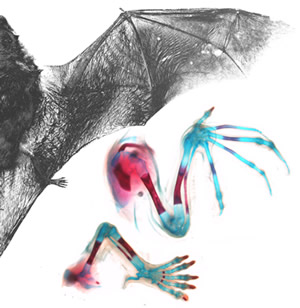| Research | Publications | Lab members |

Professor Nicola Illing nicola.illing@uct.ac.za | Telephone +27 21 650 2414 | Facsimile +27 21 650 1861 |
| Research |
|
My primary research interest is to use the tools of modern genetics to unravel the answers to interesting evolutionary and developmental biology questions, using examples from the rich biological landscape of southern Africa. Genetic analysis of organisms that are currently alive can be used to delve into the past, for example, understanding how flight evolved in the Natal long finger bat, Miniopterus natalensis 50 million years ago. Similarly, we are using genetics and cell biology to understand how vegetative desiccation tolerance evolved in Xerophyta resurrection plants, and how floral symmetry is broken in the mirror image flowers of Wachendorfia paniculata and Cyanella alba. |
| Illing publications (most recent 10 publications) |

|
| Lab members |
|
Mamosa Ngcala |
|
Evolution of vegetative desiccation tolerance in Xerophyta resurrection plants European Commission Funded project: RESIST Collaborators: Assoc. Prof. Robert Ingle (UCT), Prof. Zoran Nikoloski (University of Potsdam), Dr Rafe Lyall (Centre for Plant Systems Biology and Biotechnology, Plovdiv, Bulgaria), Prof. Yariv Brotman (Ben-Gurion University of the Nedev, Israel) Xerophyta species, including Xerophyta elegans, Xerophyta humilis, and Xerophyta schlechteri can survive desiccation at all stages of plant development. Most Xerophyta species dismantle the thylakoid membranes in their chloroplasts, and break their chlorophyll down (i.e are poikilochlorophyllous) as leaves desiccate. However X. elegans does not (ie is homoiochlorophyllous), preferring to grow in the shade. We are using a comparative genome analysis between these three Xerophyta species to unlock the conserved genetic signatures that allow drying without dying. An analysis of miRNA-seq, RNA-seq, metabolite and lipid datasets generated from a detailed sampling of X. elegans seedlings undergoing desiccation and subsequent rehydration will be used to decipher the gene regulatory networks underpinning protection against desiccation, and the subsequent recovery, without major changes in the structure of chloroplasts. |
|
The biology of left-right asymmetry - linking structural determinants to ecology and evolution Human Frontiers Research Programme (HFSP) Funded project: Collaborative project including Prof. Michael Lenhard, University of Potsdam, Prof. Spencer Barratt (University of Toronto), Dr Eva Denium (University of Wagenenin), Prof. Bruce Anderson (University of Stellenbosch), Assoc. Prof. Robert Ingle and Prof. Dirk Lang (University of Cape Town). The body plans of most plants and animals are symmetrical. Understanding how symmetry is broken is an important question in biology. For example, in flowers, the female and male reproductive organs (ie the pistil and stamen) are usually symmetrically placed relative to each other. In rare cases, this symmetry is broken. These plants have mirror-image flowers, and are referred to as being enantiostylous. We are studying this problem in Wachendorfia paniculata and Cyanella alba, where the style (part of the pistil) is directed either to the left or right of the midline, while the anthers point in the other direction. Half the population of these plants are either left- or right-handed, and thus we know that this patterning must be determined by simple genetic control. Our research seeks to
Further listening and reading Illing N, Robertson C. (2022) Barberetta aurea and the intriguing phenomenon of asymmetrical flowers. PlantLife 53.4 Podcast by Prof. Bruce Anderson |
